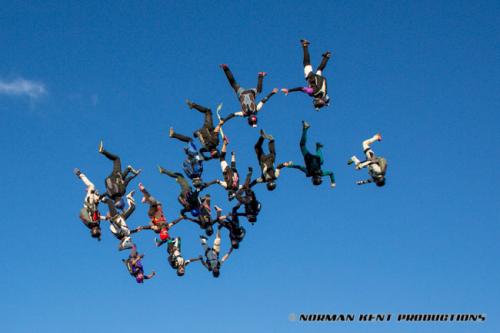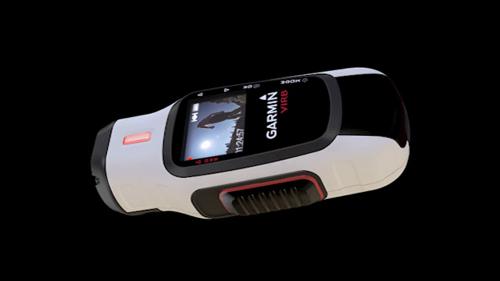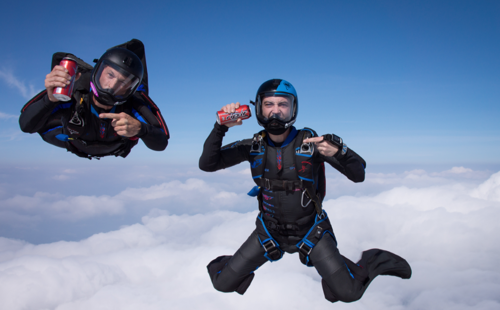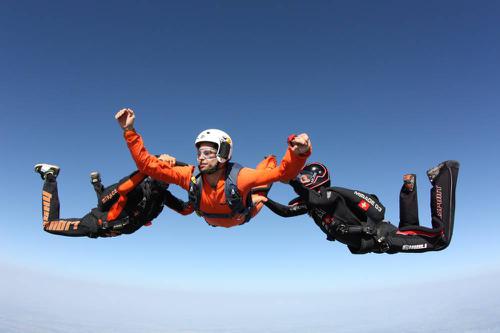This article first appeared in Parachutist magazine, and has been republished with consent of the author.
Not surprisingly, most doctors say no - don't jump while you're pregnant. Doctors are conservative, and few will recommend that their patients engage in a high-risk sport. They do not want to call an activity safe and then get blamed if something goes wrong. But many pregnant women have jumped during pregnancy with no ill effects to either themselves or their babies. So is it safe? Skydiving is a risky sport, and an accident involving an expectant mother would be doubly tragic. But presumably, we jumpers are old pros at weighing the risks of our sport against the benefits, and most of us long ago decided that the fun outweighs the danger. We wouldn't be jumping if we expected to die or to get hurt.
USPA does not give medical advice, and it is definitely not recommending that pregnant women skydive. Every pregnancy is different, and each woman has to decide for herself whether she wants to continue jumping for part or all of the nine months. If your doctor tells you that your pregnancy is high-risk and that you should avoid your usual activities, you probably shouldn't jump. If you simply feel uncomfortable taking the risks inherent in skydiving, you should ground yourself. The fact is, however, that women are jumping while pregnant and will continue to do so. Not surprisingly, there has been little or no research on jumping during pregnancy, and medical professionals hesitate to make any blanket statements about the practice. But medical advice, as well as advice from other skydivers who have jumped while pregnant, can help you decide whether to continue jumping during pregnancy, and if you do, help you do it safely.
Know Your Limits
These days, doctors tell women with low-risk pregnancies that they can continue all their normal activities as long as they feel good enough, with the caveat that they should avoid sports that contain a risk of falls and should not exercise to the point of exhaustion. "The Harvard Guide to Women's Health" says, "Pregnancy is usually not a good time to take up skiing or skydiving, but women who were already engaged in athletics can usually continue to enjoy them during pregnancy."
Women who have just started jumping should probably take a break from the sport. Most women who have continued to jump during pregnancy were very experienced and very current. Many of them also say they were in good physical condition. Drs. William and Martha Sears in "The Pregnancy Book" counsel pregnant women to know their limits and to stop their activities immediately if they feel dizzy or short of breath, have a bad headache or hard heart-pounding or experience contractions, bleeding or pain.
Pregnant women should also go easy on their joints. Relaxing and other hormones loosen joints during pregnancy, making them less stable and prone to injury if overstressed. The pelvis, lower back and knees are especially vulnerable. Skydivers should take particular care in packing and at pull time so as not to jolt their loosened joints.
A pregnant skydiver should pay attention to how she feels at all times. Fatigue is normal, and you should rest as much as you need. First-trimester nausea is a fact of life for some women, and calling it morning sickness is inaccurate, many women feel sick all the time. Being under canopy may only make you feel worse. Doctors don't allow pregnant women to take ibuprofen (Advil and Motrin) or any of the other effective analgesics, because they can cause difficulties with labor and harm the fetus.
Acetaminophen (Tylenol) is OK, but bear in mind that if you sprain an ankle or worse, you won't be able to do much for the pain. Obstetricians usually advise pregnant women to give up contact sports. As we all know, skydiving is sometimes more of a contact sport than we intend for it to be. Women who have jumped while pregnant often recommend that you be very careful about who you jump with, avoiding anyone whose freefall abilities might be suspect. Washington-state load organizer Art Bori points out that exit position can be important for two reasons: A pregnant woman may have difficulty maneuvering into position, and some positions are more dangerous than others. He always asks pregnant jumpers about their exit preferences. He tries to keep pregnant women out of the base so that they won't be in serious funnels.
Chance of Miscarriage
Can a hard opening cause a miscarriage? Dr. Scott Chew, a Colorado emergency physician and skydiver, says that no one has studied the effect of hard openings on pregnancy. Most hard openings are less traumatic than many automobile accidents, and during opening, jumpers are in a different body position than car passengers, with no belt passing over the uterus. He doesn't think a hard opening is very likely to precipitate a sudden miscarriage. He has never heard of a miscarriage occurring during skydiving, bungee jumping or rock climbing, all sports that use similar gear.
According to Chew, women should also consider the possibility of a bad landing, although the baby is quite well protected in the uterine environment. Usually the jumper would get hurt first. Emergency room doctors make a practice of treating a pregnant woman before turning their attention to the fetus, because if the mother survives, the baby likely will as well. Dr. Stanley Filip, associate clinical professor of obstetrics and gynecology at Duke University Medical Center, says that because the rapid deceleration in skydiving can be analogous to a moderate-speed auto accident or a fall while skiing (both are known to cause miscarriages), he recommends against skydiving while pregnant. On the other hand, the Sears say that miscarriages usually result from chromosomal abnormalities in the fetus, infections, hormonal deficiencies, immune-system abnormalities and environmental toxin such as drugs or cigarette smoke. Sex, safe exercises, heavy lifting, usual work and play, stress or emotional upsets or minor falls or accidents rarely cause them.
Registered nurse Marian Blackwell comments that the most important consideration is probably how the woman and her mate feel about the issue. Any woman who fears that jumping might cause her to miscarry should not jump. If a woman or the prospective father will likely blame a miscarriage on the woman’s skydiving, she is probably better off sitting out for a few months. Blackwell points out that it’s very difficult to have a miscarriage intentionally, and if a woman loses a baby while jumping, she probably would have anyway. Still, there is always a risk, and she advises that both parents need to accept this if the mother keeps jumping.
Hypoxia
What about hypoxia? Dr. Filip says that the obstetricians commonly advise woman that it’s safe to fly on commercial airlines that are pressurized during flight, but unpressurized flight above 5,000 to 7,000 feet may not provide enough oxygen to some fetuses. According to Sears, “While a short time spent in an unpressurized cabin at about 7, 000 feet is unlikely to harm your baby (baby's oxygen level in the womb is already lower than mother's), it can reduce the oxygen in your blood, causing you to feel light headed and impair your thinking and ability to move.” Chew points out that women must consider the chance of hypoxia, claiming that it's unknown whether it causes a problem for pregnant jumpers. He says, however, that the fetus is accustomed to an atmosphere less rich in oxygen than the mother needs and thus feels hypoxia less than an adult would. He adds that jump planes spend relatively little time at high altitudes, not really long enough to hurt the jumper or her baby. USPA defines high altitude as 20,000 feet up to 40,000 feet MSL and intermediate altitude as 15,000 feet to 20,000 feet MSL. USPA considers anything below 15,000 feet MSL low altitude. Routine low-altitude jumps, the sort sport jumpers commonly practice, do not generally present a risk of hypoxia. USPA does not require the use of supplemental oxygen for low-altitude jumps but has made no recommendations specific to pregnant women. (The FAA requires oxygen when required aircraft crew members are above 12,500 feet for more than 30 minutes and at all times above 14,000 feet MSL.)
Most women who have jumped during pregnancy say they did not have any trouble with hypoxia. Paula Philbrook, who participated in last year's 246-way world record while pregnant, used supplemental oxygen on the attempts. She used an oximeter to measure her oxygen saturation and found that at 13,500 feet with oxygen, her saturation level always stayed at 98 to 100 percent. Without oxygen, her saturation stayed in the mid-90s which her respiratory therapist found acceptable. According to the therapist, as long as her oxygen saturation stayed above 90 percent, she remained in the safety zone. She used oxygen starting at 10,000 feet for jumps on which she went above 15,000 feet. She found herself short of breath at 21,000 feet when the oxygen went off in preparation for exit but always felt fine as soon as she got into freefall.
Long-time style and accuracy competitor Nancy LaRiviere says a doctor advised her to use supplemental oxygen if she went above 5,000 feet. She rented an oxygen bottle from a local medical supply house, used a cannula (a tube used to breathe the oxygen) from 3,000 feet to altitude, shut off the flow on jump run and left the bottle strapped in the plane. She sat at the back of the plane on all loads to make this convenient. Some skydivers and doctors worry that a jumper could get an air embolism, an air bubble in the blood - a danger associated with pressure changes and one risk of scuba diving. Chew points out that the pressure differences involved in skydiving are not nearly as great as in scuba diving a jumper has to go to 17,000 feet to get to half atmosphere. So although a potential risk lurks, it does so less than in deep diving. All skydivers and air travelers should refrain from air travel for 24 hours after scuba diving.
Weather Considerations
Heat poses an added danger, especially in the first trimester. The Mayo Clinic “Complete Book of Pregnancy” says that says that if the mother’s internal temperature exceeds 104 degrees, the chance the fetus will have neural tube defects increases. The Sears recommend that an expectant mother eat and drink regularly while exercising to prevent dehydration and hypoglycemia. Pregnant women, particularly those further along, should be careful about flying in bad weather. Dr. Filip says that turbulent weather can sometimes stimulate pre-term labor and rupture of the fetal membranes, causing the amniotic fluid to leak. High winds and turbulence also present the standard difficulties with landing. Many pregnant jumpers advise staying on the ground on windy days.
Gearing Up
Women who jump while pregnant inevitably have to make some adjustments to their skydiving gear. Some of them change their canopies for larger mains or mains which open more softly than their original gear. Others continue to use the same gear until they quit. Either way, the jumper should feel comfortable with her gear and be able to land it well. Larger gear may feel unwieldy but often lands more softly.
A pregnant woman will quickly outgrow her normal jumpsuit. Whatever a skydiver decides to wear, she needs to ensure that she can still find all her handles. Size can also make it difficult to get in and out of airplanes. After a certain point, you may no longer fit into a little Cessna 182. Getting up and down off the floor will challenge you, so airplanes without benches become less than ideal. You'll really learn to appreciate tailgates and planes with seats.
How long can a woman keep jumping while she is pregnant? Women have jumped into their fifth, sixth and seventh months. Some jumpers go by the folk wisdom "jump until you show." Others stop based on the time of year. If you’re five months pregnant in July with sweltering heat, that might be the time you call it quits. When you decide that you're no longer operating at 100 percent, stay on the ground until you fee! back up to speed.
Postpartum
Many women have found that skydiving after they give birth requires more adjustment than jumping while expecting. LaRiviere says she had to change her jumpsuit only after the baby was born and she was nursing him. Nursing also required some changes to her harness.
What to do with the baby during jumping time poses a bigger problem. LaRiviere's husband acted as primary caregiver during her training camps, and she hired a niece to watch the baby while she competed in the nationals. If your baby doesn't sleep through the night, chances are you don’t either. You may not want to put yourself in freefall in such an addled state. If both husband and wife jump, they may want to take turns going to the drop zone. Often, couples jump less than they did before becoming parents. Also, even a minor injury would probably cause tremendous inconvenience with a small baby, so conservative is better.
Starting Them Young
Skydiving during pregnancy is definitely possible, though it gives the jumper a lot to think about. As Chew points out, skydiving carries the risk of injury and death, and pregnant jumpers have additional considerations, including some not addressed here. All potential jumpers need to make that decision for themselves with the available information and in consultation with their own families and physicians. Pregnant skydiving adds a new wrinkle to the sport. For example, how do you count a pregnant skydiver participating in the 246-way world record? Does she make it a 247-way? Either way, these kids will have cool stories to recount when they're older. How many kindergartners get to tell their classmates they already have 20 minutes of freefall?
About the Author
Amy Hackney Blackwell is an attorney and freelance writer in Greenville South Carolina. She has been skydiving since 1995.









